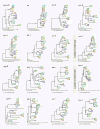Gene genealogies indicates abundant gene conversions and independent evolutionary histories of the mating-type chromosomes in the evolutionary history of Neurospora tetrasperma
- PMID: 20673371
- PMCID: PMC2923516
- DOI: 10.1186/1471-2148-10-234
Gene genealogies indicates abundant gene conversions and independent evolutionary histories of the mating-type chromosomes in the evolutionary history of Neurospora tetrasperma
Abstract
Background: The self-fertile filamentous ascomycete Neurospora tetrasperma contains a large (approximately 7 Mbp) and young (< 6 MYA) region of suppressed recombination within its mating-type (mat) chromosomes. The objective of the present study is to reveal the evolutionary history, including key genomic events, associated with the various regions of the mat chromosomes among ten strains representing all the nine known species (lineages) contained within the N. tetrasperma species complex.
Results: Comparative analysis of sequence divergence among alleles of 24 mat-linked genes (mat A and mat a) indicates that a large region of suppressed recombination exists within the mat chromosome for each of nine lineages of N. tetrasperma sensu latu. The recombinationally suppressed region varies in size and gene composition among lineages, and is flanked on both ends by normally recombining regions. Genealogical analyses among lineages reveals that eight gene conversion events have occurred between homologous mat A and mat a-linked alleles of genes located within the region of restricted recombination during the evolutionary history of N. tetrasperma.
Conclusions: We conclude that the region of suppressed recombination in the mat chromosomes has likely been subjected to independent contraction and/or expansion during the evolutionary history of the N. tetrasperma species complex. Furthermore, we infer that gene conversion events are likely a common phenomenon within this recombinationally suppressed genomic region. We argue that gene conversions might provide an efficient mechanism of adaptive editing of functional genes, including the removal of deleterious mutations, within the young recombinationally suppressed region of the mat chromosomes.
Figures


Similar articles
-
The mating-type chromosome in the filamentous ascomycete Neurospora tetrasperma represents a model for early evolution of sex chromosomes.PLoS Genet. 2008 Mar 14;4(3):e1000030. doi: 10.1371/journal.pgen.1000030. PLoS Genet. 2008. PMID: 18369449 Free PMC article.
-
Large-scale introgression shapes the evolution of the mating-type chromosomes of the filamentous ascomycete Neurospora tetrasperma.PLoS Genet. 2012;8(7):e1002820. doi: 10.1371/journal.pgen.1002820. Epub 2012 Jul 26. PLoS Genet. 2012. PMID: 22844246 Free PMC article.
-
Evidence of the accumulation of allele-specific non-synonymous substitutions in the young region of recombination suppression within the mating-type chromosomes of Neurospora tetrasperma.Heredity (Edinb). 2011 Oct;107(4):305-14. doi: 10.1038/hdy.2011.11. Epub 2011 Mar 9. Heredity (Edinb). 2011. PMID: 21386869 Free PMC article.
-
Recombination suppression and evolutionary strata around mating-type loci in fungi: documenting patterns and understanding evolutionary and mechanistic causes.New Phytol. 2021 Mar;229(5):2470-2491. doi: 10.1111/nph.17039. Epub 2020 Dec 1. New Phytol. 2021. PMID: 33113229 Free PMC article. Review.
-
Neurospora from Natural Populations: Population Genomics Insights into the Life History of a Model Microbial Eukaryote.Methods Mol Biol. 2020;2090:313-336. doi: 10.1007/978-1-0716-0199-0_13. Methods Mol Biol. 2020. PMID: 31975173 Review.
Cited by
-
Nuclear interactions in a heterokaryon: insight from the model Neurospora tetrasperma.Proc Biol Sci. 2014 Jul 7;281(1786):20140084. doi: 10.1098/rspb.2014.0084. Proc Biol Sci. 2014. PMID: 24850920 Free PMC article.
-
Evolutionary strata on young mating-type chromosomes despite the lack of sexual antagonism.Proc Natl Acad Sci U S A. 2017 Jul 3;114(27):7067-7072. doi: 10.1073/pnas.1701658114. Epub 2017 Jun 19. Proc Natl Acad Sci U S A. 2017. PMID: 28630332 Free PMC article.
-
Large-scale suppression of recombination predates genomic rearrangements in Neurospora tetrasperma.Nat Commun. 2017 Oct 26;8(1):1140. doi: 10.1038/s41467-017-01317-6. Nat Commun. 2017. PMID: 29074958 Free PMC article.
-
Contrasted patterns in mating-type chromosomes in fungi: hotspots versus coldspots of recombination.Fungal Biol Rev. 2015 Dec 1;29(3-4):220-229. doi: 10.1016/j.fbr.2015.06.001. Fungal Biol Rev. 2015. PMID: 26688691 Free PMC article.
-
Unequal recombination and evolution of the mating-type (MAT) loci in the pathogenic fungus Grosmannia clavigera and relatives.G3 (Bethesda). 2013 Mar;3(3):465-80. doi: 10.1534/g3.112.004986. Epub 2013 Mar 1. G3 (Bethesda). 2013. PMID: 23450093 Free PMC article.
References
-
- Dodge BO. Nuclear phenomena associated with heterothallism and homothallism in the ascomycete Neurospora. J Agr Res. 1927;35:289–305.
Publication types
MeSH terms
Substances
LinkOut - more resources
Full Text Sources
Miscellaneous

